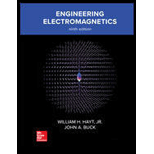
Concept explainers
Let us assume that we have a very thin, square, imperfectly conducting plate 2 m on a side, located in the plane z = 0 with one corner at the origin such that it lies entirely within the first quadrant. The potential at any point in the plate is given as V= -e-x sin y. (a) An electron enters the plate at x = 0, y = đ�œ‹/3 with zero initial velocity, in what direction is its initial movement? (b) Because of collisions with the particles in the plate, the electron achieves a relatively low velocity and little acceleration (the work, that the field does on it is converted largely into heat). The electron therefore moves approximately along a streamline. Where does it leave the plate and in what direction is it moving at the time?
Want to see the full answer?
Check out a sample textbook solution
Chapter 4 Solutions
Engineering Electromagnetics
- 5) ) The point charge at the bottom of the figure is, Q = 17 nC and the curve is a circular arc, of radius r = 5 cm. What is the magnitude of the force on the charge Q due to the other point charges shown? -6.0 nC 2.0 nC 2.0 nC 45° 45° 5.0 cm 5.0 cm +) Explain or Show Work Here:arrow_forwardIn the figure particles 2 and 4, of charge -e, are fixed in place on a y axis, at y₂ = -8.38 cm and y4 = 4.19 cm. Particles 1 and 3, of charge - e, can be moved along the x axis. Particle 5, of charge +e, is fixed at the origin. Initially particle 1 is at x₁ = -8.38 cm and particle 3 is at x3 = 8.38 cm. (a) To what x value must particle 1 be moved to rotate the direction of the net electric force Fnet on particle 5 by 30° (b) With particle 1 fixed at its new position, to what x value must you move particle 3 to rotate back to its original counterclockwise? direction? (a) Number i (b) Number i Units Units 10arrow_forwardFor the circuit shown in Figure:a. Determine the reluctance values and show themagnetic circuit, assuming that μ = 3,000μ0.b. Determine the inductance of the device.c. The inductance of the device can be modified bycutting an air gap in the magnetic structure. If a gapof 0.1 mm is cut in the arm of length l3, what is thenew value of inductance?d. As the gap is increased in size (length), what is thelimiting value of inductance? Neglect leakage fluxand fringing effects.arrow_forward
- Two positive point charges of Q1=5.9 µC and Q2=5.00 µC are fixed on the x-axis as shown in the figure. Find the magnitude of the net electric force (in N) on a third negative charge of q=-2.00 µC placed at the origin. 8.00 cm 1.20 cmarrow_forwardThe cube has sides of L-10cm. The electric field is uniform, has a magnitude of 500V/m and directed along x-axis. What is the electric flux through each of the cube faces located in y-z plane? inVm, 1 significant figurearrow_forwardTwo infinite wires are charged uniformly with linear charge density as shown in the figure. What is the magnitude of the electric field (in N/C) at point B? Given that (d)=0.5 m. +12 nC/m +6 nC/m •B d Select one: O a. 503.54 O b. 72 O c. 359.67 O d. 215.8 O e. 647.4arrow_forward
- Two positive point charges are equal to +5 nC on the x-axis, one at the center and the other at x = 8 cm. Find the potential at point P1 x = 4cm and point P2 y = 6 cm!arrow_forwardA series of six infinite charged sheets are placed on positive x-axis at a distance of 5 um with each other. Consider the first sheet is placed at x=0. The third sheet is grounded. The Electric field is 5x10 N/C and is uniform in the region. Calculate the potential at the first sheet and the last sheet respectively. (a) -5 V and 7.5 V (b) 5 V and -7.5 V (c) -7.5 V and 5 V (d) 7.5 V and - 5 V Answerarrow_forwardtwo charges q1=-2c and q=-2c are at the two vertices of an equilateral triangle having a side length of 0.5 m. what amount of electric field intensity is at the third vertex of the triangle if a positive test charge is placedarrow_forward
- Ieft Fight There is a uniformly distributed negative charge on the semicircle shown. What O? O A) left O B) up CyC) rigth D) downarrow_forwardME. 2. A positive point charge q = 3μC is surrounded by a sphere with radius 0.2m centered on the charge. Find the electric flux through the sphere due to this charge. Select one: O a. 300000 Nm2/C b. 340000 Nm2/C O c. 430000 Nm2/C O d. 400000 Nm2/C Clear my choicearrow_forwardAn electron moves east in a uniform 14 N / C electric field directed west. At point A, the velocity of the electron is 8 * 10⁵ m / s to the east. What is the speed of the electron when it reaches point B, 75 m east of point A?arrow_forward
 Introductory Circuit Analysis (13th Edition)Electrical EngineeringISBN:9780133923605Author:Robert L. BoylestadPublisher:PEARSON
Introductory Circuit Analysis (13th Edition)Electrical EngineeringISBN:9780133923605Author:Robert L. BoylestadPublisher:PEARSON Delmar's Standard Textbook Of ElectricityElectrical EngineeringISBN:9781337900348Author:Stephen L. HermanPublisher:Cengage Learning
Delmar's Standard Textbook Of ElectricityElectrical EngineeringISBN:9781337900348Author:Stephen L. HermanPublisher:Cengage Learning Programmable Logic ControllersElectrical EngineeringISBN:9780073373843Author:Frank D. PetruzellaPublisher:McGraw-Hill Education
Programmable Logic ControllersElectrical EngineeringISBN:9780073373843Author:Frank D. PetruzellaPublisher:McGraw-Hill Education Fundamentals of Electric CircuitsElectrical EngineeringISBN:9780078028229Author:Charles K Alexander, Matthew SadikuPublisher:McGraw-Hill Education
Fundamentals of Electric CircuitsElectrical EngineeringISBN:9780078028229Author:Charles K Alexander, Matthew SadikuPublisher:McGraw-Hill Education Electric Circuits. (11th Edition)Electrical EngineeringISBN:9780134746968Author:James W. Nilsson, Susan RiedelPublisher:PEARSON
Electric Circuits. (11th Edition)Electrical EngineeringISBN:9780134746968Author:James W. Nilsson, Susan RiedelPublisher:PEARSON Engineering ElectromagneticsElectrical EngineeringISBN:9780078028151Author:Hayt, William H. (william Hart), Jr, BUCK, John A.Publisher:Mcgraw-hill Education,
Engineering ElectromagneticsElectrical EngineeringISBN:9780078028151Author:Hayt, William H. (william Hart), Jr, BUCK, John A.Publisher:Mcgraw-hill Education,





